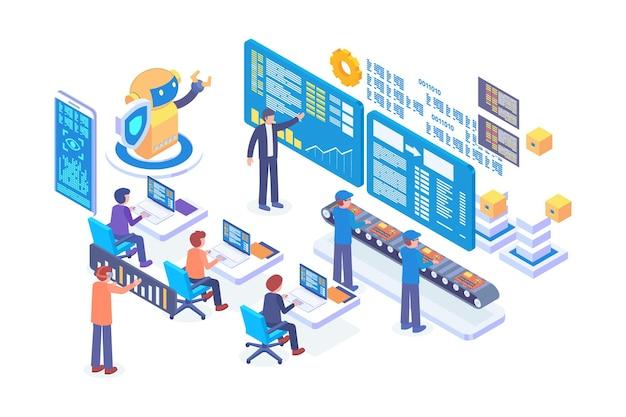In today’s competitive business landscape, organizations are increasingly recognizing the importance of data-driven decision-making. HR metrics and workforce analytics provide valuable insights into the performance and effectiveness of human resources within an organization. By leveraging these metrics, businesses can make strategic decisions that optimize talent management, improve employee engagement, and drive overall organizational success. In this blog post, we will explore the different types of HR metrics and delve into the realm of workforce analytics to understand their significance in today’s dynamic workplace. But before we dive in, let’s first understand what HR metrics and analytics truly encompass.
HR Metrics and Workforce Analytics: A Peek into the Data-driven World of HR
Harnessing the Power of Data
In today’s fast-paced and data-driven world, HR departments are increasingly turning to HR metrics and workforce analytics to make informed decisions about their workforce. Gone are the days of relying solely on gut instinct or vague impressions. With the help of data, HR professionals can uncover valuable insights and trends, enabling them to optimize recruitment, retention, and overall employee satisfaction.
The Endless Possibilities of HR Metrics
HR metrics provide a wealth of information about various aspects of the workforce, from employee performance and productivity to diversity and inclusion. These metrics allow HR teams to track key indicators and measure their impact on employee engagement and organizational success. With this data, HR professionals can identify areas of improvement, set goals, and make data-backed decisions that align with the company’s overall strategy.
A World Beyond Basic Metrics
Gone are the days when HR metrics were limited to basic data such as employee turnover rates or time-to-fill vacant positions. Today, workforce analytics takes HR metrics to a whole new level. By utilizing advanced algorithms and artificial intelligence, HR professionals can delve deeper into the data, uncovering correlations and patterns that were previously hidden. This empowers HR teams to make more accurate predictions and proactive decisions that have a direct impact on the bottom line.
Analyzing the Impact of HR Initiatives
With the help of HR metrics and workforce analytics, HR professionals can measure the effectiveness of various HR initiatives. Whether it’s a new training program or a revamped performance management system, data can reveal whether these initiatives are truly making a difference or falling flat. By quantifying results, HR teams can adjust strategies as needed and focus on initiatives that yield the highest return on investment.
Driving Transparency and Accountability
One of the significant benefits of HR metrics and analytics is the ability to drive transparency and accountability within organizations. By openly sharing data with employees, HR teams can foster a culture of trust and collaboration. Employees can have a clear understanding of how their performance is evaluated and how their contribution aligns with organizational goals. This transparency encourages employees to take ownership of their work and actively contribute to the company’s success.
Embracing the Data Revolution
As HR departments continue to embrace data-driven approaches, HR metrics and workforce analytics will play a fundamental role in shaping the future of HR. By harnessing the power of data, HR professionals can make informed decisions, improve employee engagement, and drive organizational success. So, it’s time to embrace the data revolution and unlock the endless possibilities that HR metrics and workforce analytics offer.
HR Metrics Formulas
Why HR Metrics Matter (And How to Make Them Fun!)
When it comes to HR metrics, formulas can seem like the beast we’re all afraid to face. But fear not! Understanding these formulas is easier than you might think, and I promise to make it fun along the way.
Formula #1: Employee Retention Rate
The employee retention rate is like trying to calculate how many chocolate chip cookies your office mates will eat in a week – tricky, but important! To keep it simple, here’s the formula: (Number of Employees at End of Period – Number of Employees Who Left during Period) / Number of Employees at Start of Period x 100.
Formula #2: Cost per Hire
Calculating the cost per hire can be as confusing as figuring out who ate the last slice of pizza at your team lunch. Fear not, my friend, for I have the formula that will make it all clear: (Total External Recruiting Costs + Internal Recruiting Costs) / Number of Hires. Now you’ll know exactly how much that slice of pizza costs (in terms of hiring expenses)!
Formula #3: Training Investment per Employee
Training investment per employee is like trying to calculate the amount of coffee your team consumes in a month – it’s vital information! The formula here is: Total Training Costs / Number of Employees. Now you can sleep soundly knowing just how much coffee is keeping your team productive.
Formula #4: Overtime Percentage
Calculating the overtime percentage is akin to figuring out how many hours you spend watching cat videos at work (we won’t tell!). The formula for this one is: (Total Overtime Hours Worked / Total Regular Hours Worked) x 100. Now you’ll know who’s really been watching those cat videos!
Formula #5: Turnover Cost
Calculating the turnover cost is like determining how much that fancy lunch you had last week cost you in terms of your monthly budget. The formula for this mystery lies in: (Separation Costs + Vacancy Costs + Replacement Costs) / Total Number of Employees. You can now put an actual price tag on that fancy lunch!
With these fun and enlightening HR metric formulas, you’ll be able to impress your colleagues and make data-driven decisions. Remember, metrics don’t have to be dull – they can be as entertaining as your favorite sitcom! So go forth, calculate, and conquer!
3 Types of HR Metrics
Introduction
When it comes to human resources, collecting and analyzing data can be a real game-changer. But the sheer volume of HR metrics out there can be overwhelming. So, let’s break it down and bring some humor into the mix!
The “Time Warp” Metrics
Ever feel like you’ve stepped into a time machine when dealing with HR? Well, these metrics can help you make sense of the past, present, and future!
1. “Turnover Time Machine” Metric
This metric measures how quickly employees come and go in your company. It’s like discovering your own personalized time machine, but instead of zapping you to the future, it takes you back to the moments when employees bid farewell or said hello. As you analyze this metric, you can unlock patterns, identify key reasons for turnover, and even predict future talent movements.
2. “Absenteeism Analyzer” Metric
Have you ever wondered what’s going on when employees mysteriously disappear? This metric can shed some light on the situation. Step into the “Absenteeism Analyzer” metric, and you’ll uncover the reasons behind those empty desks. Whether it’s the flu season or annual leave, this metric can help you identify trends and adjust your policies accordingly.
The “Performance Powerhouse” Metrics
It’s time to take a closer look at how your employees are performing. These metrics will help you evaluate individual and team performance, making you the superhero of the office!
3. “Productivity Potion” Metric
Ever wish you had a magic potion to boost productivity? Well, this metric is as close as it gets! The “Productivity Potion” metric measures the output generated by each team member. By comparing it to the average, you’ll quickly discover who’s casting spells of high productivity and who might need a little extra enchantment.
4. “Superstar Spotlight” Metric
Every company has its superstars, those shining employees who constantly go above and beyond. This metric will bring them into the spotlight they deserve! It tracks individual achievements, awards, and recognition. With the “Superstar Spotlight” metric, you can acknowledge and reward your top performers, motivating them to keep up the fantastic work.
When it comes to HR metrics, there’s something for everyone. Whether you’re analyzing turnover or measuring productivity, these metrics can help you understand and improve the inner workings of your workforce. So, dive into the data, embrace your inner HR detective, and let these metrics be your trusty sidekicks on your journey to HR success!
What Are HR Metrics and Analytics
Human resources can be a mysterious world filled with acronyms and confusing jargon. One such term you may have come across is “HR metrics and analytics.” But fear not, dear reader, for I am here to demystify this enigma and bring a ray of clarity into your HR universe.
Understanding the Basics
At its core, HR metrics and analytics is the process of gathering and analyzing data related to the workforce. Think of it as HR’s version of CSI, where we collect, examine, and interpret data to uncover valuable insights about our employees and the organization as a whole.
Peeking Behind the Curtain
HR metrics allow us to measure different aspects of the workforce, such as employee performance, turnover rates, recruitment effectiveness, and diversity and inclusion. These metrics provide us with valuable information that can help us make informed decisions, identify trends, and drive strategic initiatives.
Embracing the Power of Numbers
But why should we care about these metrics? Well, my friend, numbers tell stories, and HR metrics enable us to understand the narrative of our workforce. By analyzing data, we can pinpoint areas of improvement, make objective decisions, and tailor our strategies to meet the needs of our employees.
Unleashing the Potential of Workforce Analytics
Now, let’s dive a little deeper into the world of workforce analytics. This exciting field takes HR metrics to the next level by using statistical modeling, data mining, and predictive analytics. With workforce analytics, we can go beyond just measuring the present state and start predicting future outcomes and trends.
From Reactive to Proactive
By leveraging workforce analytics, HR professionals can transition from a reactive mindset to a proactive one. Instead of waiting for issues to arise, we can anticipate challenges, identify potential bottlenecks, and develop strategies to create a flourishing and engaged workforce.
The Possibilities are Endless!
With HR metrics and workforce analytics, the sky’s the limit! From improving employee engagement to optimizing recruitment strategies, this powerful duo can revolutionize how we approach human resources. So go forth, my fellow reader, and embrace the world of HR metrics and analytics with open arms.
In conclusion, HR metrics and analytics are not just buzzwords floating around the HR world; they are tools that enable us to make data-driven decisions, understand our workforce better, and create strategies that drive organizational success. Don’t be intimidated by the numbers; instead, let them guide you on a journey to HR greatness!
Human Resource Metrics and Talent Analytics
Understanding the World of HR Metrics
In today’s dynamic workplace, HR professionals are constantly looking for ways to measure and analyze their workforce effectively. Enter the world of HR metrics and talent analytics, where data reigns supreme, and insights are sought after like buried treasure. But fear not, dear reader, for we shall embark on a journey through this fascinating realm, shedding light on its intricacies and uncovering its hidden secrets.
The Quest for the Right Metrics
In the realm of HR, metrics are the holy grail, the compass that guides decisions and shapes strategies. However, not all metrics were created equal, and finding the right ones can sometimes feel like searching for a needle in a haystack. Whether it’s measuring employee engagement, tracking turnover rates, or assessing the effectiveness of training programs, HR professionals are armed with an arsenal of metrics to make sense of the ever-changing dynamics of the workforce.
Decoding Talent Analytics
Ah, talent analytics! It’s like having a crystal ball that reveals the potential of your workforce. By analyzing data on recruitment, performance, and employee development, talent analytics provides invaluable insights into the strengths and weaknesses of individuals and the organization as a whole. Gone are the days of relying on gut feelings and guesswork when it comes to making decisions about hiring, promotions, and investments in employee growth. With talent analytics, the future is crystal clear—well, almost.
The Hidden Perils of Metrics
While HR metrics and talent analytics are incredibly powerful tools, one must tread carefully in their usage. Misinterpreting or relying solely on numbers can lead to dire consequences. For instance, focusing too much on productivity metrics might neglect the importance of employee well-being or engagement. Remember, behind every data point lies a human being, and a balance must be struck between the quantitative and qualitative aspects of HR.
Embracing the World of HR Metrics and Talent Analytics
Dear reader, now that we’ve ventured into the world of HR metrics and talent analytics, we hope you’ve gained a fresh perspective on just how influential and enlightening these tools can be. So go forth, armed with knowledge and armed with data, and may you navigate the complexities of the workforce with grace, humor, and a touch of analytical genius. Happy metric hunting!
What Sets HR Analytics Apart from Workforce Analytics
Introduction
When it comes to HR metrics and analytics, there’s a lot of talk about HR analytics and workforce analytics. But wait, aren’t they the same thing? Well, not quite! In this subsection, we’ll dive deep into the differences between these two terms and show you why they are not as interchangeable as you might think. So, let’s buckle up and get ready for a humorous and enlightening journey through the realms of HR analytics and workforce analytics!
Defining HR Analytics
Starting with the basics, HR analytics focuses on analyzing and interpreting data related to human resources activities. It involves crunching numbers and using statistical methods to gain insights into various HR processes, such as recruitment, employee performance, and training. In simpler terms, HR analytics is all about understanding and maximizing the potential of the human capital within an organization.
Exploring Workforce Analytics
On the other hand, workforce analytics takes a broader approach. It encompasses not only HR-related data but also looks into broader workforce trends and patterns. It explores the interconnectedness between HR data and other business metrics to understand the impact of workforce strategies on overall organizational performance. In a nutshell, workforce analytics zooms out to see the bigger picture and how the workforce as a whole contributes to the success of the organization.
The Fine Line Between Them
Now that we’ve defined both terms, let’s draw a clearer line between HR analytics and workforce analytics. While HR analytics focuses on specific HR functions (think employee engagement, retention, and performance management), workforce analytics takes it a step further by analyzing how those HR functions impact the organization’s bottom line.
Connecting the Dots
To put it simply, HR analytics zooms in to analyze HR-specific data, while workforce analytics zooms out to analyze the connection between HR data and overall business outcomes. It’s like comparing a single puzzle piece to the complete picture – they’re both crucial, but they serve different purposes.
The Power Duo
Although HR analytics and workforce analytics have their distinct territories, they’re not enemies. In fact, they make a powerful duo when used together. By combining the insights gained from HR analytics with the broader context provided by workforce analytics, organizations can make more informed decisions and develop strategies that align HR goals with overall business objectives.
In the end, what sets HR analytics apart from workforce analytics is the scope of their analysis. While HR analytics takes a deep dive into HR-specific data, workforce analytics looks at the bigger picture of how HR influences the overall organization. So, next time you hear someone talking about HR analytics or workforce analytics, remember that there’s a fine line differentiating the two – and now you have the inside scoop!
Time to Put It into Practice
With a clear understanding of the differences between HR analytics and workforce analytics, you can now start exploring how these powerful tools can revolutionize your organization’s approach to managing human capital. So, gear up, gather your data, and embark on an analytics adventure that will ultimately lead to a brighter future for your HR and workforce strategies.
Resources for Further Exploration
To dig deeper into the fascinating world of HR and workforce analytics, here are some resources you may find useful:
- The HR Analytics Handbook: A Practical Guide to Using Data for People Decisions
- Workforce Analytics: Strategies for Delivering Business Value
Remember, knowledge is power, so keep exploring and unlocking the potential of HR and workforce analytics!
What to Consider Before Using HR Metrics and Workforce Analytics
Why Crunching the Numbers Isn’t Always a Piece of Cake
Are you ready to dive into the world of HR metrics and workforce analytics? Well, hold your horses! Before you jump headfirst into this data-driven adventure, there are a few things you should consider. After all, you wouldn’t want to end up in a numerical nightmare that’s more puzzling than a Rubik’s Cube. So, before you start crunching those numbers, keep these points in mind:
1. Don’t Get Lost in the Metric Maze
There’s a plethora of HR metrics out there, like turnover rate, productivity index, and satisfaction score. It’s like being trapped in a labyrinth of numbers! Instead of getting overwhelmed, take a step back and figure out which metrics align with your organization’s goals and objectives. Choose metrics that truly matter and are relevant to your unique business needs. Remember, it’s quality over quantity!
2. Beware of Data Delusions
Ah, data – it’s like a box of chocolates, you never know what you’re gonna get! While HR metrics and workforce analytics can provide valuable insights, don’t let yourself fall into the trap of relying solely on numbers. Data can be deceiving, so always complement it with qualitative feedback and a healthy dose of common sense. Remember, behind those numbers are real human beings, not just pixels on a screen!
3. Nurture a Data-Driven Culture (Without Going Overboard)
Embracing HR metrics and workforce analytics is fantastic, but don’t turn your workplace into a robotic dystopia. Sure, data is important, but don’t forget the power of human interaction and intuition. Encourage your team to use data as a tool rather than a dictator. Foster a culture where data and gut feelings mingle harmoniously, like the perfect blend of peanut butter and jelly. Let the numbers guide you, but never forget the human touch.
4. Break Free from the Spreadsheet Shackles
Beware the dreaded spreadsheet black hole! It’s easy to get caught up in never-ending rows and columns, losing sight of the bigger picture. Remember, HR metrics and workforce analytics are meant to enhance decision-making, not shackle you to your desk with endless data entry. Embrace user-friendly software and automation tools that simplify the process, freeing up your time for more important tasks like enjoying a good cup of coffee.
5. Keep It Legal and Ethical (Or Be Prepared for Some Serious Side-Eye)
When it comes to HR metrics and workforce analytics, make sure you play by the rules. Privacy and ethical considerations should always be at the forefront of your mind. Don’t be like that friend who constantly breaks the rules in a board game just to win. Ensure data security, respect privacy rights, and obtain proper consent. Trust us; you don’t want your organization to be known as the “Data Bandit” around town. Be ethical, be responsible, and avoid the side-eye.
Remember, HR metrics and workforce analytics can be powerful tools if used wisely. So, before you start your data journey, take a moment to consider these points. With a bit of humor and a touch of common sense, you’ll be well on your way to unlocking the potential of HR metrics and workforce analytics. Get ready to crunch those numbers like a pro and make data-driven decisions that will drive your organization forward!
The Primary Purpose for the Use of HR Metrics and Workforce Analytics is to…
Improve decision-making and strategy formulation
When it comes to running a business, making informed decisions is crucial. HR metrics and workforce analytics enable organizations to gather and analyze data to gain valuable insights into their workforce. With this information, leaders can make data-driven decisions that impact the organization’s overall strategy and performance. Gone are the days of relying on gut feelings and guesswork. Now, businesses can make strategic decisions based on concrete evidence.
Track and enhance employee performance
Employee performance is a key factor in the success of any organization. HR metrics and workforce analytics allow companies to track employee performance on various levels, from individual to team and even department-wide. By using these metrics, companies can identify high-performing employees, acknowledge their achievements, and provide them with opportunities for growth. Simultaneously, struggling employees can receive the necessary support and training to improve their performance. This data-driven approach helps create a culture of continuous improvement within the workforce.
Optimize workforce planning and resource allocation
One of the main purposes of HR metrics and workforce analytics is to optimize workforce planning and resource allocation. By analyzing data on factors such as employee turnover rate, productivity, and skill gaps, organizations can identify areas where additional resources or adjustments may be required. This enables HR teams to allocate resources more efficiently, ensuring that the right people are in the right roles at the right time. Ultimately, this results in increased productivity, reduced costs, and a more effective allocation of resources.
Enhance employee engagement and retention
Employee engagement and retention are vital for organizations looking to thrive in a competitive market. By utilizing HR metrics and workforce analytics, companies can assess and measure employee engagement levels within the organization. This data allows HR teams to identify areas where changes and improvements can be made to enhance employee satisfaction and retention. Whether it’s through implementing new benefits programs, improving work-life balance, or providing opportunities for professional development, HR metrics and workforce analytics help create a work environment that attracts, engages, and retains top talent.
Drive diversity and inclusion initiatives
Diversity and inclusion have become critical focus areas for many organizations today. HR metrics and workforce analytics play a significant role in driving these initiatives. By analyzing data on diversity and inclusion metrics, such as representation across different demographics and employee surveys regarding inclusivity, companies can identify areas for improvement and develop strategies to promote diversity. The insights gleaned from HR metrics and workforce analytics help organizations create a more inclusive and equitable workplace, fostering innovation and creativity.
In conclusion, HR metrics and workforce analytics bring numerous benefits to organizations. From improving decision-making and tracking employee performance to optimizing resource allocation and driving diversity and inclusion initiatives, the comprehensive insights provided by these tools help businesses thrive in the fast-paced world of HR. So, embrace the power of data, laugh in the face of uncertainty, and let HR metrics and workforce analytics guide your organization towards success!



